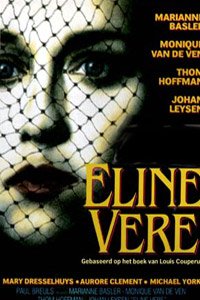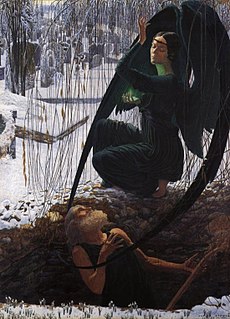This article deals with literature written in Dutch during the 19th century in the Dutch-speaking regions.
Holland Park Press is an independent, privately owned, London based publishing house. It was founded in 2009 by Bernadette Jansen op de Haar.

Dutch Indies literature or Dutch East Indies literature is a section of Dutch literature encompassing Dutch language literature inspired by colonial and post-colonial Insulinde from the Dutch Golden Age to the present day. It includes Dutch, Indo-European and Indonesian authors. Its subject matter thematically revolves around the VOC and Dutch East Indies era, but also includes the postcolonial discourse.
Clara Bell, née Poynter (1835–1927), was an English translator fluent in French, German, Danish, Dutch, Italian, Norwegian, Russian, and Spanish, noted for her translations of works by Henrik Ibsen, Balzac, Georg Ebers, Huysmans, Maupassant, Pérez Galdós and others. She was educated in France, where she became fluent in French and German; she did not acquire her knowledge of the other languages until after her fortieth birthday. She spent most of her life in London.

The Hidden Force is a 1900 novel by the Dutch writer Louis Couperus. The narrative is set on the island of Java in the Dutch East Indies. The book was adapted into a 1974 Dutch TV serial. In 2010, a feature-film adaptation was announced as under development with Paul Verhoeven as director.
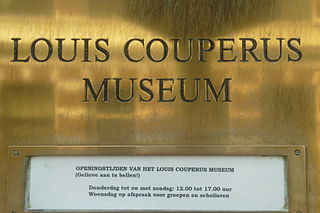
The Louis Couperus Museum is a museum located in the Archipelbuurt neighbourhood of The Hague. The museum celebrates the life and work of the Belle Époque writer Louis Couperus.

Surinamestraat 20 in The Hague is the location of the house where the Dutch writer Louis Couperus wrote his novel Eline Vere. The father of Couperus, John Ricus Couperus (1816-1902) gave orders to build this house; he first sold his estate "Tjicoppo", which was located near Buitenzorg in the Dutch East Indies and then returned to the Netherlands, where he and his family moved into this house. John Ricus Couperus lived here until his death in 1902 and then the house was put up for sale.
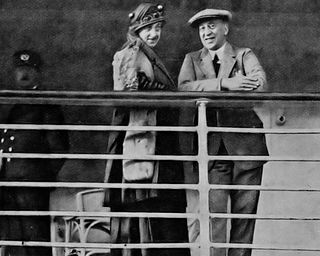
Elisabeth Wilhelmina Johanna (Betty) Couperus-Baud, was a Dutch translator. She was the wife of the Dutch writer Louis Couperus (1863–1923).

Orchids, a collection of prose and poetry is a collection of prose and poetry written by Dutch writer Louis Couperus, which was published in 1886. Couperus published his debut, A ribbon of poems in 1886 with publisher J.L. Beijers. The rights to publish Couperus' books were taken over by publisher A. Rössing, who then published the second book of Couperus, Orchids, a collection of prose and poetry. After Rössing filed for bankruptcy in 1890 the rights were taken over by L.J. Veen, who would publish the second edition in 1895. In 1989 Veen would reprint Orchids, when Couperus' complete works were published.
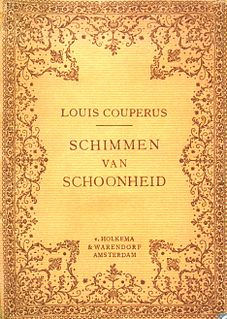
Schimmen van schoonheid is a collection of short stories, written by Louis Couperus and published by Van Holkema & Warendorf in 1912. It is not known how many copies were printed for the first edition, but this edition was in any case sold out by 1929. The second edition was published in 1962 by Querido in the so-called Salamander series.

Footsteps of Fate is a novel written by Louis Couperus and published in 1891. Footsteps of Fate was first published in the Dutch magazine "De Gids". In 1891 the novel was translated into English by Clara Bell and published under the title Footsteps of Fate. The first two Dutch editions were published by Elsevier ; the second to eighth editions were published by L. J. Veen, except for the sixth edition, which was published by De samenwerkende Uitgevers. The English translation was published with Heinemann's International Library, under the authority of Edmund Gosse. His attention was drawn to this book by Maarten Maartens.

Ecstasy: A Study of Happiness is a novel written by Louis Couperus and published in 1892 by L.J. Veen in a first edition of 1,250–1,500 copies. A second edition was printed in 1894 and a third in 1905. Ecstasy was the first book of Couperus that was published by L.J. Veen, later his regular publisher. Couperus received a wage of 550 guilders for the first edition. Ecstasy was first published in the Dutch literary magazine The Gids. The book was translated into English by Alexander Teixeira de Mattos in 1919 and published by Dodd, Mead and Company.

Williswinde is a collection of verses written by Dutch writer Louis Couperus. The first edition was published by L.J. Veen in 1895. In 1904 Veen acquired full rights of Williswinde and 16 other works that were written by Couperus. For the first edition in 1894 Couperus received 200 guilders and the poems by that time had already been published in a number of Dutch newspapers and magazines. However Couperus had some difficulty to get the poem Williswinde published, as he wrote in a letter to a colleague, Smit Kleine. The book cover was designed by painter Ludwig Willem Reymert Wenckebach.
LGBT writers in the Dutch-language area are writers from de Lage Landen, that is Flanders and the Netherlands,

Bastiaan Johan "Bas" Heijne is a Dutch writer and translator.
Jacob Hiegentlich was a gay Dutch poet of Jewish descent. He committed suicide in 1940, at age 33, days after the German invasion of the Netherlands.

